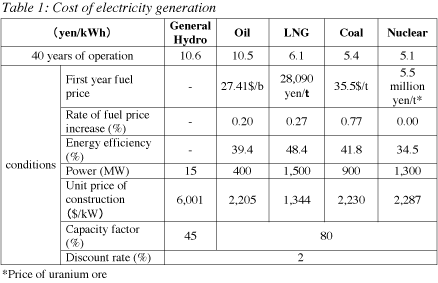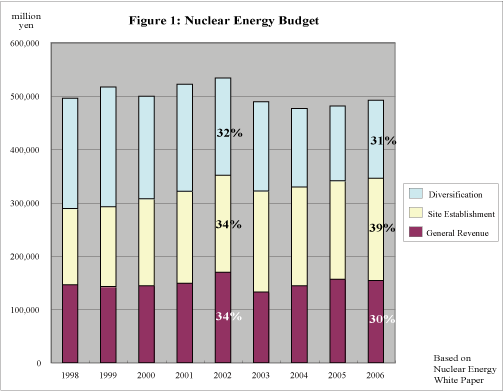Cost of Nuclear Power in Japan
This article considers costs associated with nuclear energy which were not included in an electricity generation cost comparison published in 2003 by the Agency for Natural Resources and Energy (ANRE). ANRE’s figures are shown in table 1. Costs are shown for general hydro, fossil fuels (3 types) and nuclear, based on 40 years’ operation. The main conditions are also shown.

Based on this comparison, nuclear energy has been promoted as being cheaper, or at least no more expensive than other energy sources. Looking at the above table, one immediately notes the dubious assumption that nuclear fuel prices will remain constant for 40 years. The discount rate also has a significant impact on the calculation of the cost of nuclear power plants. ANRE’s calculation assumes that disposal of high level waste begins 48 years from the date the calculation was made and continues till 90 years from the date of calculation. By applying ANRE’s discount rate, the cost of disposal is reduced to one fourth the undiscounted cost.
However, by delving a little deeper, one discovers that there are costs peculiar to nuclear energy which were completely omitted from the calculation.
Nuclear energy costs not included in the above calculation
The Japanese government spends more than any other government on energy research and development. Nuclear energy receives 64% of this, by far the greatest portion. By comparison, only 8% is spent on renewable energy, while 12% is spent on energy efficiency etc.. It is reasonable to say that this R&D funding is necessary in order for nuclear energy to be able to continue.
The government’s nuclear energy budget is published in an official nuclear energy white paper. The nuclear energy budget for the last 10 years is shown infigure 1 below. It amounts to about 500 billion yen each year.
Around one third is from general revenue. The rest is from special accounts. There are two special accounts, one for the “diversification of electric power” and one for “site establishment”. The funds for these special accounts come from a special purpose tax called the Electric Power Development Tax. Currently the tax is collected from consumers via their electricity bills at the rate of 400 yen per 1,000 kWh. The revenue is distributed in accordance with the Law for the Adjustment of Areas Adjacent to Power Generating Facilities.
This system was introduced in 1974. The Prime Minister at the time was Kakuei Tanaka, the Treasurer was Takeo Fukuda, and the Minister of International Trade and Industry was Yasuhiro Nakasone. During the debate in the House of Representatives, many reasons were given why local agreement would be hard to obtain. Environmental and safety problems were raised. The point was made that “The increased employment and the stimulation to the local economy from nuclear power plants are much less than can be expected from other industries.” The above system was introduced in order to “smooth the introduction of nuclear power by promoting the provision of public facilities necessary to improve the welfare of people living in areas adjacent to power generating facilities.” Minister Nakasone remarked, “People living where nuclear power plants are built suffer considerable inconvenience.” He went on to say, “A balance cannot be achieved if residents do not receive some welfare benefits in return.” It can be said that this is a peculiarly Japanese system.
Each year around 154 billion yen ($1.4 billion) is provided to local self-governing bodies. It is used for such things as the construction of roads, government office buildings, libraries and hospitals. Recently the system was amended to make it possible to also use these funds for the maintenance of these facilities. According to the Fukui Newspaper, this system was “the most effective thing in gaining local approval for the expansion of nuclear power plants”. The increasingly aggressive use of the system is also very striking. For example, as a result of a modification introduced in the 2004 fiscal year, the subsidy is increased for local governments which accept pluthermal (see NIT 100).
The system was changed in 1980 so that, in addition to providing subsidies to adjacent areas, revenues from the Electric Power Development Tax could be spent on research and development for the electricity generation system. Subsidies for adjacent areas came from the site establishment account, while funds for R&D came from the electric power diversification account. Indeed, the majority of the funds from the electric power diversification account have been used to fund nuclear energy related R&D. At the time the change was made, all of the R&D expenses of Power Reactor and Nuclear Fuel Development Corporation (PNC later became JNC and is now absorbed into JAEA – see NIT 109) were funded from this account. Thus, the government’s nuclear energy R&D spending came to be funded from a special account separate from general revenue.
The government’s nuclear energy budget hovers around 500 billion yen ($4.5b). Private R&D investment (27 billion yen ($247m) in 2003) is well below 10% of government spending on nuclear energy, so clearly the government has provided huge subsidies to the nuclear industry. Without these subsidies, the industry wouldn’t have survived.
The 2004 nuclear energy budget was 465 billion yen ($4.2b). If the 37 billion yen ($335m) allocated to accelerator and fusion-related work is deducted, this comes to 428 billion yen ($3.9b). Nuclear power generation in 2004 was 282,442 million kWh, so the government’s subsidy to nuclear energy works out at 1.5 yen/kWh (1.38 cents/kWh). (Japan’s nuclear energy policy is based on the fuel cycle, so the government’s spending on the nuclear fuel cycle is included in this figure.)
Strictly speaking, this 1.5 yen/kWh subsidy cannot simply be added to the cost of nuclear energy generation shown in Table 1. This is because the cost of nuclear energy calculated by ANRE is averaged over 40 years. Nevertheless, it is clear that nuclear energy in Japan is not as cheap as it is made out to be.
Hideyuki Ban (CNIC Co-Director)

